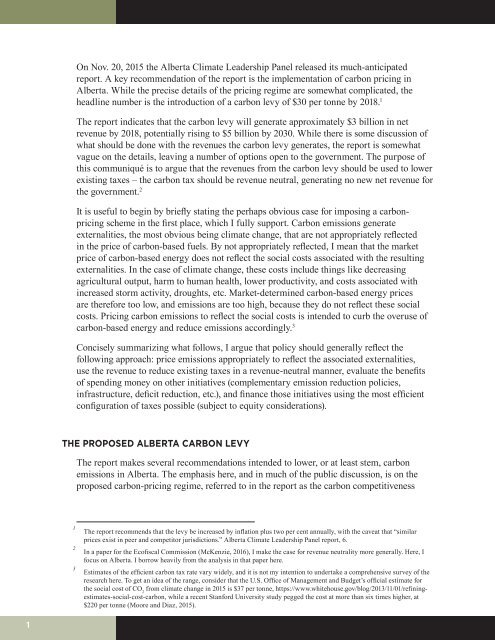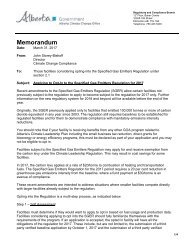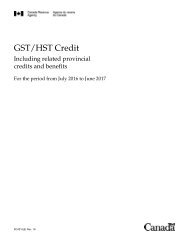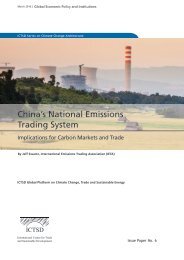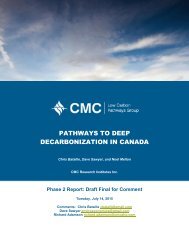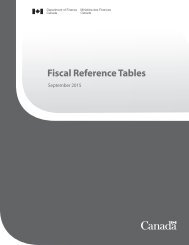MAKE THE ALBERTA CARBON LEVY REVENUE NEUTRAL
carbon-levy-revenue-neutral-mckenzie
carbon-levy-revenue-neutral-mckenzie
Create successful ePaper yourself
Turn your PDF publications into a flip-book with our unique Google optimized e-Paper software.
On Nov. 20, 2015 the Alberta Climate Leadership Panel released its much-anticipated<br />
report. A key recommendation of the report is the implementation of carbon pricing in<br />
Alberta. While the precise details of the pricing regime are somewhat complicated, the<br />
headline number is the introduction of a carbon levy of $30 per tonne by 2018. 1<br />
The report indicates that the carbon levy will generate approximately $3 billion in net<br />
revenue by 2018, potentially rising to $5 billion by 2030. While there is some discussion of<br />
what should be done with the revenues the carbon levy generates, the report is somewhat<br />
vague on the details, leaving a number of options open to the government. The purpose of<br />
this communiqué is to argue that the revenues from the carbon levy should be used to lower<br />
existing taxes – the carbon tax should be revenue neutral, generating no new net revenue for<br />
the government. 2<br />
It is useful to begin by briefly stating the perhaps obvious case for imposing a carbonpricing<br />
scheme in the first place, which I fully support. Carbon emissions generate<br />
externalities, the most obvious being climate change, that are not appropriately reflected<br />
in the price of carbon-based fuels. By not appropriately reflected, I mean that the market<br />
price of carbon-based energy does not reflect the social costs associated with the resulting<br />
externalities. In the case of climate change, these costs include things like decreasing<br />
agricultural output, harm to human health, lower productivity, and costs associated with<br />
increased storm activity, droughts, etc. Market-determined carbon-based energy prices<br />
are therefore too low, and emissions are too high, because they do not reflect these social<br />
costs. Pricing carbon emissions to reflect the social costs is intended to curb the overuse of<br />
carbon-based energy and reduce emissions accordingly. 3<br />
Concisely summarizing what follows, I argue that policy should generally reflect the<br />
following approach: price emissions appropriately to reflect the associated externalities,<br />
use the revenue to reduce existing taxes in a revenue-neutral manner, evaluate the benefits<br />
of spending money on other initiatives (complementary emission reduction policies,<br />
infrastructure, deficit reduction, etc.), and finance those initiatives using the most efficient<br />
configuration of taxes possible (subject to equity considerations).<br />
<strong>THE</strong> PROPOSED <strong>ALBERTA</strong> <strong>CARBON</strong> <strong>LEVY</strong><br />
The report makes several recommendations intended to lower, or at least stem, carbon<br />
emissions in Alberta. The emphasis here, and in much of the public discussion, is on the<br />
proposed carbon-pricing regime, referred to in the report as the carbon competitiveness<br />
1<br />
2<br />
3<br />
The report recommends that the levy be increased by inflation plus two per cent annually, with the caveat that “similar<br />
prices exist in peer and competitor jurisdictions.” Alberta Climate Leadership Panel report, 6.<br />
In a paper for the Ecofiscal Commission (McKenzie, 2016), I make the case for revenue neutrality more generally. Here, I<br />
focus on Alberta. I borrow heavily from the analysis in that paper here.<br />
Estimates of the efficient carbon tax rate vary widely, and it is not my intention to undertake a comprehensive survey of the<br />
research here. To get an idea of the range, consider that the U.S. Office of Management and Budget’s official estimate for<br />
the social cost of CO 2<br />
from climate change in 2015 is $37 per tonne, https://www.whitehouse.gov/blog/2013/11/01/refiningestimates-social-cost-carbon,<br />
while a recent Stanford University study pegged the cost at more than six times higher, at<br />
$220 per tonne (Moore and Diaz, 2015).<br />
1


